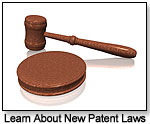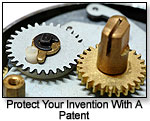 |

Tools:








America Invents Act of 2011: Considerations for the Toy and Game Industry
 The Leahy-Smith Act The Leahy-Smith Act
On September 16, 2011, President Obama signed the Leahy-Smith Act and enacted the most significant change to the U.S. patent laws in almost 60 years. Headlines focus on the Act’s aligning of U.S. patent law with those of the nation’s international trade partners, the most anticipated news being the change from a first-to-invent system to a first-to-file system.
See the official bill here
However, due to the staggered effective dates of the Act’s provisions, many changes will likely have practical implications only after September 16, 2012, and the much talked about first to invent system will not actually take effect until March 16, 2013. Between now and these “down the road” effective dates, the U.S.P.T.O. will revise its examination guidelines and regulations as necessary to comport with the new laws.
See all the effective dates here
A few provisions of the America Invents Act did take effect already. Many of these early provisions affect specialized industries, such as microbiology and certain business methods. This article will focus on a few provisions that toy and game manufacturers should consider.
Increase in Fees
Perhaps not surprisingly, the already in-effect provisions include an increase in U.S.P.T.O. filing, search, examination and other office fees. The early provisions also bring some benefits to large entities, and a new “micro entity” alike. Large entities may now expedite the examination of its applications by remitting a one-time fee of $4800 per application. Small entities (those who satisfy the Small Business Administration size standards*) may expedite at a reduced rate of $2400.
*According to the Small Business Administration Game, Toy, and Children’s Vehicle Manufacturing and Doll and Stuffed Toy Manufacturing companies must have no more than 500 employees to be considered a small entity. A Table of Small Business Size Standards for these and other industries can be seen here (PDF).
"Micro Entity" Established
The Act also provides for a new “micro entity.” This provides discounts of 75% for basic PTO filing fees. Micro-entity status applies to individuals with an annual income no more than three times the average median income of the previous year. The individual also cannot be named as an inventor on more than four prior patent applications, and should not be subject to an obligation of assignment to an entity that does not qualify as a micro-entity.
Best Mode
 On matters of substance, two sections merit consideration at the present time. The first relates to a prohibition against invalidating a patent based on failure of the patent applicant to disclose the “best mode” of carrying out the invention. This applies for all lawsuits started on or after September 16, 2011, and thus applies to all new patent applications. Both the present and past patent laws require an inventor to provide an adequate description of the invention so that one skilled in the art can make and use the invention. The disclosure serves as the “quid pro quo” for garnering a limited monopoly for one’s inventive labor. On matters of substance, two sections merit consideration at the present time. The first relates to a prohibition against invalidating a patent based on failure of the patent applicant to disclose the “best mode” of carrying out the invention. This applies for all lawsuits started on or after September 16, 2011, and thus applies to all new patent applications. Both the present and past patent laws require an inventor to provide an adequate description of the invention so that one skilled in the art can make and use the invention. The disclosure serves as the “quid pro quo” for garnering a limited monopoly for one’s inventive labor.
The past patent laws also required the inventor to disclose the “best mode” of implementing the invention. The America Invents Act still requires best mode, but it is a requirement without teeth since patent validity and enforcement cannot be challenged based on failure to satisfy best mode. This is most significant to those toys and games that potentially could be protected by maintaining features of the product as a trade secret. One area where this would apply are chemical or material-based toys (think “Silly Putty”). Another area is electronic games.
Best Mode, Trade Secrets, and Patents
Under the prior patent laws, inventors could obtain both patent and trade secret protection for their inventions. However, the delicate balance between satisfying the disclosure requirement, which included the “best mode,” and keeping any part of the “best mode” a secret basically forced inventors to pick one or the other form of intellectual property as protection. They could forego a patent and maintain the invention a trade secret. However, they risked market loss if a competitor reverse engineered the critical chemical or program code.
 Alternatively, inventors could forego the trade secret protection and expend the resources to obtain exclusivity through patent protection. Removing the specter of patent invalidity from the best mode requirement allows the inventor to strike the balance more readily. As long as the inventor is able to describe the invention such that one skilled in the art can actually make and use the invention, the inventor can obtain the patent. The inventor can also possibly keep as trade secret one or more aspects of the invention that may give the inventor an additional competitive edge. Alternatively, inventors could forego the trade secret protection and expend the resources to obtain exclusivity through patent protection. Removing the specter of patent invalidity from the best mode requirement allows the inventor to strike the balance more readily. As long as the inventor is able to describe the invention such that one skilled in the art can actually make and use the invention, the inventor can obtain the patent. The inventor can also possibly keep as trade secret one or more aspects of the invention that may give the inventor an additional competitive edge.
The second provision of present importance relates to prior user rights. If a potential infringer commercially used a process or a composition, device or machine used in a manufacturing or commercial process at least one year prior to the effective filing date of a patent, then that potential infringer has the defense of prior user rights. Such a party shares some of the benefit of early use of the invention, but without incurring the expense of the patent. This protects entities that may have conceived of a concept earlier, but for various reasons did not pursue a patent. It is, in effect, protection against a patent holder for those who kept their prior inventions a trade secret. The prior user, however, ultimately does not hold any patent rights or other rights of exclusion themselves.
Other New Provisions
Other provisions effective now include a pro bono program for inventors of limited financial means, limitations on false marking claims, changes to patent marking requirements, willful infringement considerations in the absence of a written opinion, and limitations on joinder of party defendants. The last of these provisions limit the impact of so-called “patent trolls” or non-practicing entities that would allege infringement against multiple unrelated manufacturers in a single lawsuit.
Stay tuned for a discussion of the impact of the other new laws as the U.S.P.T.O. rolls out new guidelines and rules.
 Writer's Bio: Writer's Bio: Susan Perng Pan is partner in the Washington, D.C., office of the global intellectual property firm, Sughrue Mion PLLC. She litigates multi-party complex patent disputes before several U.S. federal district courts, the U.S. International Trade Commission, and the U.S. Federal Trade Commission. Her practice also includes preparing and prosecuting patent applications, appeals and interferences before the U.S. Patent and Trademark Office. She may be contacted at span (at) sughrue.com. Read more articles by this author
THIS BANNER IS AN AD:

• • • • • • • • • • • • • • • • • • • | • • • • • • • • • • • • • • • • • • |
Back to TDmonthly's front page
|  |
Advertise on TDmonthly

|

